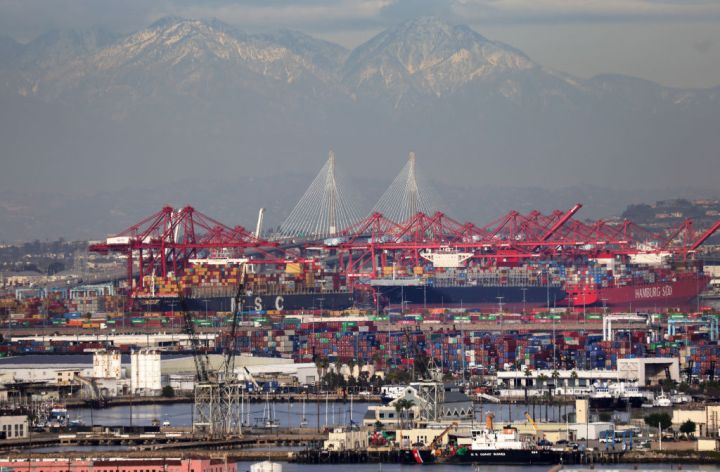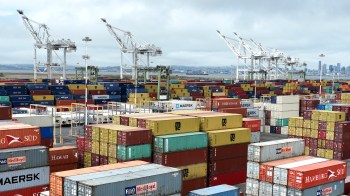
Port of LA campaigns to bring back shippers lost amid labor talks
Port of LA campaigns to bring back shippers lost amid labor talks

The Port of Los Angeles had an eventful 2022. Early in the year, it was inundated with cargo and saw record traffic even amid supply chain snags and lockdowns in Chinese shipping hubs. Then, America’s largest port by volume had to contend with labor negotiations between dockworkers and employers when their contract expired in July.
Labor negotiations are still ongoing and cargo volume has taken a hit as a result. Importers have recently diverted goods to other U.S. ports, with the Port of New York and New Jersey benefitting the most — New York claimed LA’s “busiest port” title late last year.
The Port of LA’s cargo volume dropped 20% from August through the end of 2022, said Executive Director Gene Seroka, though he expects the situation to be resolved early this year. That’s sparked an effort by port officials to bring back some clients who left over labor disruptions.
“I’ve had folks in charge … telling me they just couldn’t risk another year of telling their superiors they got caught up in the backlogs at the Southern California ports,” Seroka said in an interview with Marketplace’s David Brancaccio. “We’ve tried to give every reassurance, and before the holidays, I was crisscrossing the nation on a whistle-stop tour to try to share the ground truth with manufacturers, retailers, exporters alike on how productivity looks.”
The following is an edited transcript of their conversation.
David Brancaccio: How’s it going with volume over there? Last time we talked, it was thunderingly busy. Little less busy, I think, as the year wore on?
Gene Seroka: It’s been fairly light since August of last year, David. We had an earlier than normal peak season, with June and July setting all-time records. And then we began to see the shift of cargo away from our ports on the West Coast to the East and Gulf coast. Many importers and exporters have been telling me for some time they’re very concerned about protracted longshore labor negotiations and any type of work disruption. Of course, that hasn’t happened. And we don’t believe it will.
Brancaccio: So talk about shifting business to other ports. But you haven’t seen the actual shift happen, that’s what you’re saying?
Seroka: The shift has happened. We’re down about 20% from August through the end of the year in 2022. But the productivity of the workforce, the longshore members that are out there moving all this cargo, is at an all-time high per vessel. So we haven’t seen any work disruption. And both sides, from the employers association to the dockworkers groups, have committed to continuing the good work of moving America’s trade while the officers and executives are at the table negotiating their next contract.
Hoping for a 1st quarter labor resolution
Brancaccio: Now, you’re not in the middle of negotiations; clearly you’re affected by them. But do you have a sense that maybe those negotiations are approaching an endgame?
Seroka: From a historical perspective, we’re at the outer reaches, or the point where it usually sees conclusion. U.S. Labor Secretary Marty Walsh was in my office in Los Angeles, he was going to again visit with both sides, talk to them on the phone, make sure that they’re continuing to stay at the table and talk about these all-important issues that affect so many of us. I’d like to see this agreement completed here in the first quarter. Again, from what we’ve seen in the past on time and distance, it seems right to get these final pieces put together. But it’s still a lot of hard work for the negotiators.
Brancaccio: So first quarter, so sometime before spring, maybe?
Seroka: That’s what I hope. I don’t speak for either the union or the employers association. But we see the cargo that’s moved away from us. Some of it will stick as supply chains gets solidified in other port locations through other geographies. And I think both sides are well aware of that. Yet they’ve got real important issues to cover and make sure this next contract has a good, long runway.
Brancaccio: And as you point out, the labor negotiations are part of this. But also it was — 2020 — a crazy year in your business. You had supply chain backlogs, and then some of the backlogs were worked through, and you saw that rhythm at your port.
Seroka: I’ve had folks in charge of transportation, supply chain, import-export managers telling me they just couldn’t risk another year of telling their superiors they got caught up in the backlogs at the Southern California ports. Maybe they overcorrected. But they had to do something. Sitting and doing nothing was not an answer. We’ve tried to give every reassurance, and before the holidays, I was crisscrossing the nation on a whistle-stop tour to try to share the ground truth with manufacturers, retailers, exporters alike on how productivity looks. And our gateway is open for business.
Brancaccio: You went door to door over there, huh?
Seroka: Absolutely. East Coast, Midwest, I was in Detroit visiting with our automotive friends, the tier-one and tiered suppliers. Everyone in my Rolodex was on the list to go out and continue to share what we’re doing out here and make sure they have an understanding — the key performance indicators, all the data that we look at, to show that this gateway here with latent capacity now can help pick up the slack from other areas.
The port as an economic indicator
Brancaccio: I saw some reporting that about three-quarters of corporate economists are figuring we’re in for a recession this new year, at some point. A lot of CEOs also believe that in separate surveys. Would you be an early indicator of a recession to come? Is that how it works as you watch your volumes?
Seroka: Well, we believe so, because the traditional order-cycle process on imports, when the companies put their orders into factories, is usually 90 to 120 days before vessels sail from Asia. So we get to look at those purchase orders. Then we have a look through our Port Optimizer, port community information system, of loadings 40 days out before they arrive in Los Angeles. We can see things before others do, and I follow this economic data as we’ve talked about before, David, very closely, and it’s a landscape that we really haven’t seen before. The jobs numbers that came out were exceptionally strong. Consumer spending, especially for the holidays, when adjusted for inflation, will rival or beat last year’s all-time holiday sales records for the retail industry here in the United States. And we continue to have nearly 11 million jobs open throughout the country. Consumer demand’s surging, opportunities, producer prices still staying relatively well-elevated. And although inflation is coming down, we still see the Federal Reserve at the center of all these conversations. And with the meeting minutes have said is they’re going to continue to lean on increasing interest rates to slow the economy and pull inflation down as quickly as they can. So it looks very different than normally what we would benchmark from the past.
Brancaccio: No, I take your point, right? I mean, when you look at the underlying strength of the U.S. labor market versus what our central bankers are saying they intend to do. But often executives take an educated guess and make decisions on how much they’re going to buy from overseas based on their hunch about what’s happening, and that is something you would see first in the incoming cargo headed toward you.
Seroka: Correct. We’ve also got a fairly high level of retail inventory still here in the United States. Post-holidays, we’re seeing many major retailers, others big and small, discounting, slashing prices to try to get this old stock out into the American consumers’ hands. What we’re hearing now from our various industry partners is that it’s going to be a slow first quarter for imports based on those factors I’ve just mentioned. Lunar New Year vacation break will probably be longer than normal at about 30 days or a month, compared to the traditional seven to 10 days. So folks are going to try to continue to weed through this inventory, orders will be lighter, and then we’ll have a chance to level set timing beginning in Q2.
There’s a lot happening in the world. Through it all, Marketplace is here for you.
You rely on Marketplace to break down the world’s events and tell you how it affects you in a fact-based, approachable way. We rely on your financial support to keep making that possible.
Your donation today powers the independent journalism that you rely on. For just $5/month, you can help sustain Marketplace so we can keep reporting on the things that matter to you.


















